A California historical fact; between the years 1848-1877, one-hundred forty-nine Mexicans were lynched in mob violence. In addition, California has the dubious distinction of being one of the first places a woman was lynched. I discovered this unfortunate piece of California history when I met with Bill Schinsky; its importance related to a current work-in-progress that is consuming much of his time. For those who don’t know, Bill Schinsky is not only a talented artist, but he is the Executive Director of and is responsible for the establishment of the Coachella Valley Art Center located in Indio, California.
Bill directs me to his work-in-progress. Hanging from the ceiling in his studio space at the Coachella Valley Art Center is the first of many pieces to be installed. It is a large substructure of wire covered in dyed wool.
Bill: That’s Good! I like to see people react. I know, hanging here, it looks like a piece a meat and that’s what I want to achieve. I don’t want a literal looking body hanging here. I don’t like literal and and I feel this will be a more powerful statement. When it is complete there will be 149 hanging sculptures displayed. (opening on February 1, 2019). I’ll work on the historical approach and a fellow artist, Marni Navarro will be taking a more contemporary viewpoint, using projections and sound. It should be a reminder to all of us that this could happen again.
Bill: There is a place in Ontario called Berkeley Ergonomics that make mattresses and they give away remnants. When I was there, I picked up bags and bags of wool fleece and put them in my car and brought them here. I make the substructure with chicken wire and wrap each in this luxurious fabric that I dye. I hope for a strong reaction. One can’t hide the truth here and I never want to do that. It was the same with my last exhibitions based on my Vietnam experiences. Those were also historical as well as emotional.
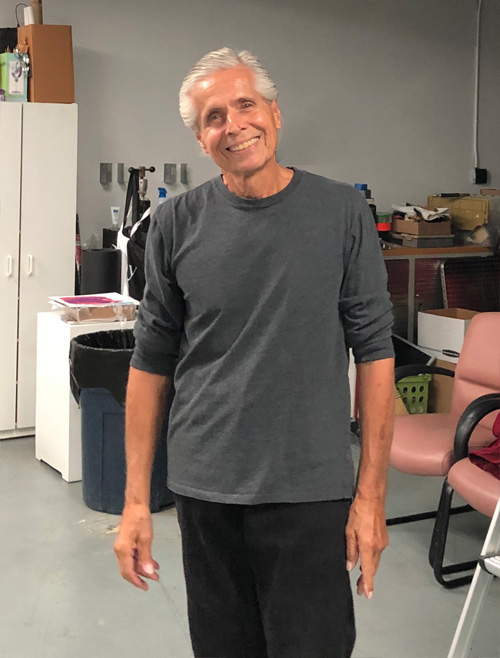
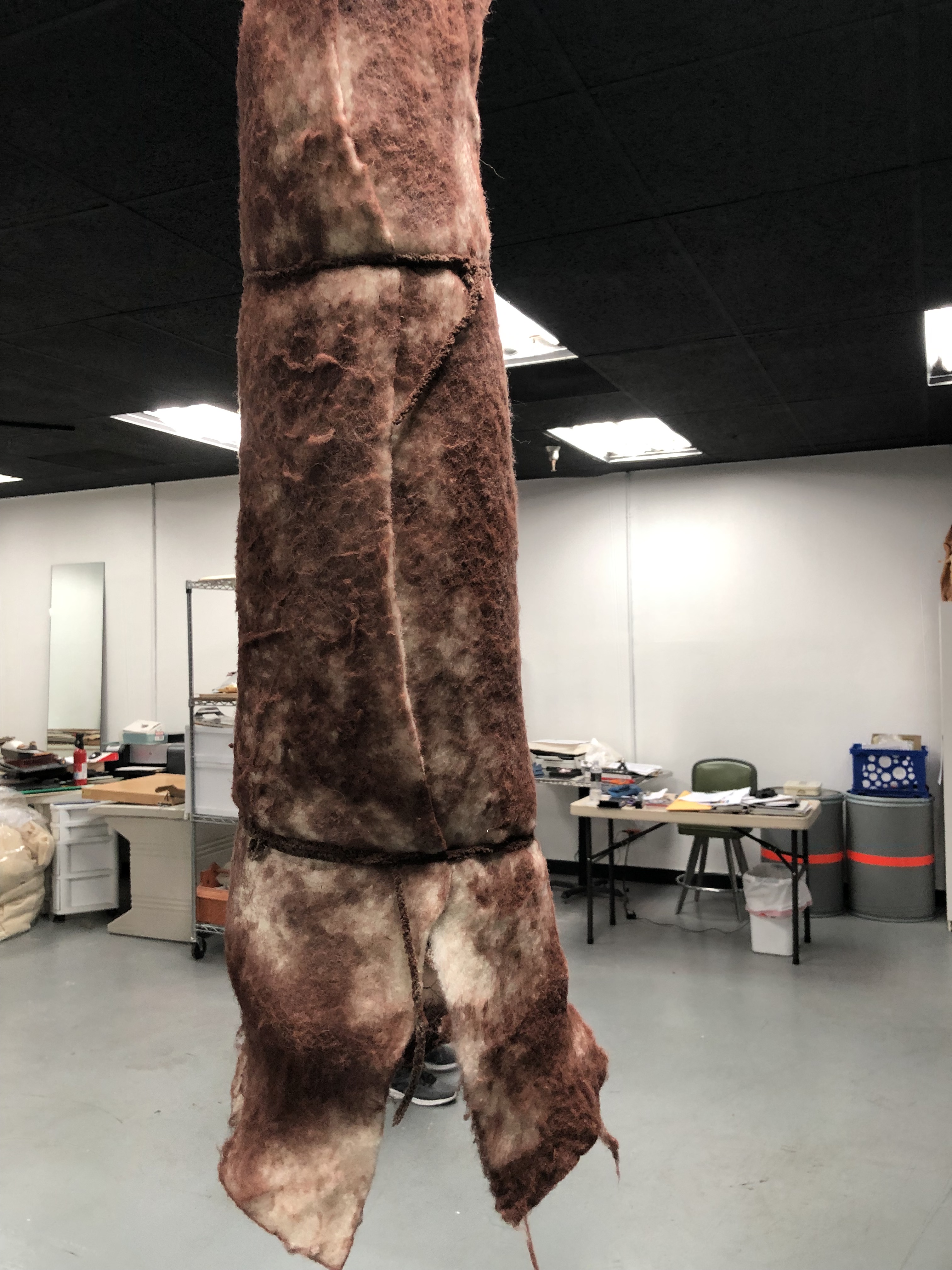
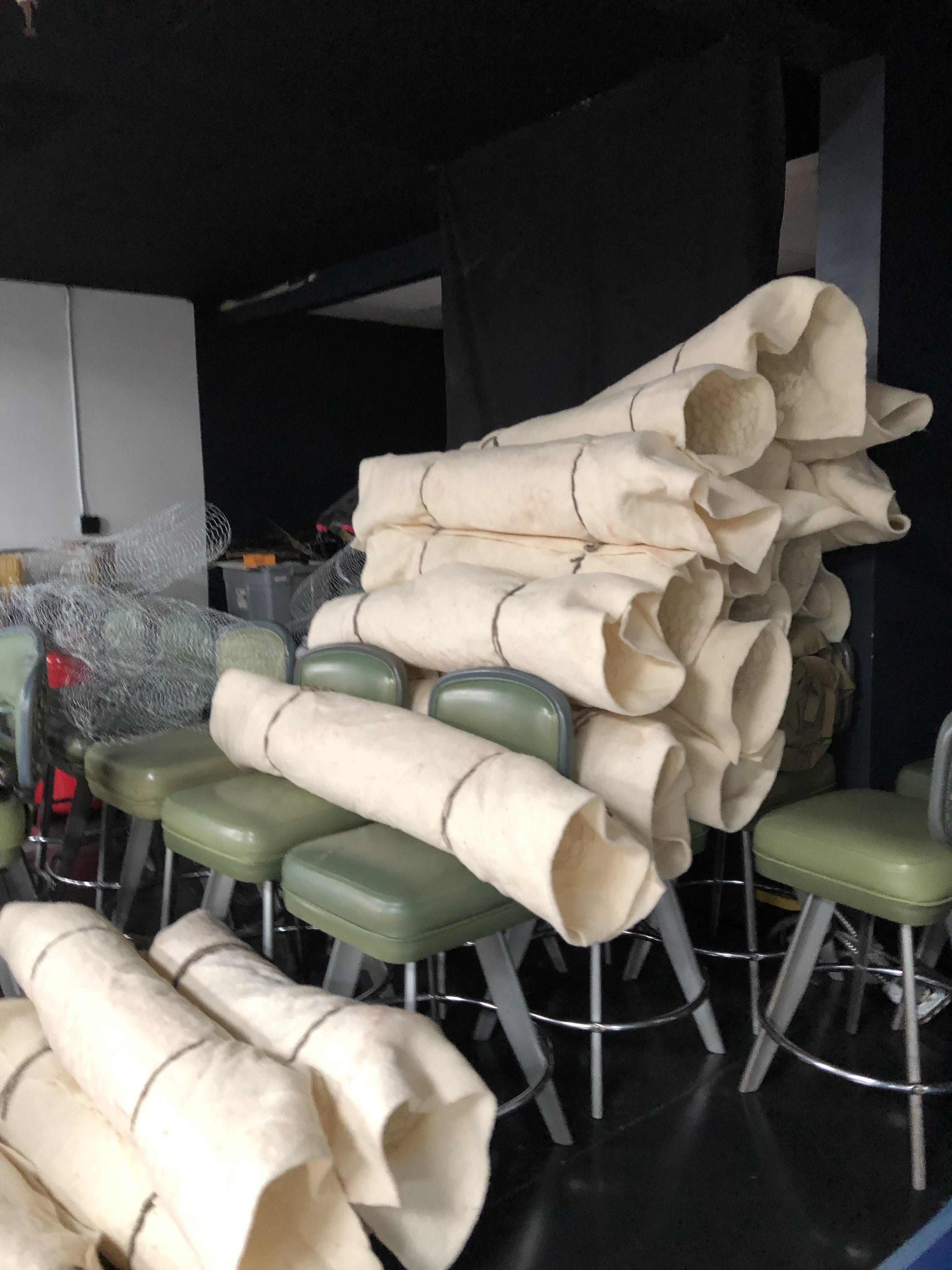
Schinsky is referring to one of his 2016 site-specific installations entitled “Quang tri-1968-1969: 420 Days in War” and was the first time, according to Bill, that he had allowed himself as an artist to think, remember and act upon his military experience. He shows me a piece from a 2017 Vietnam installation; a black circular shaped disk entitled “Ingredients or War: Napalm”.
Bill: I was twenty to twenty-one then, drafted out of school and I was, I suppose, considered old, as most guys in my unit were eighteen or nineteen. I arrived in Vietnam in 1968, near the end of the TET Offensive. If you have never seen Napalm before you don’t realize how frightening it really is. Napalm burns things, to a crisp, to charcoal, and it’s frightening. So, for this project I re-used material from the first “Quang tri” piece. I had spent hours pounding charcoal brochettes which gave me a sense of energy. These pieces are made of charcoal bits, dust and glued and poured into a form. It is the same charcoal that I will use with other pieces, over and over, in other exhibits and represents the ever-present threat of death experienced in war.
As we talk and walk through the gallery, we reminisce. We met in 2011 when the Coachella Valley Art Center was nothing more than an empty shell. Today one can’t help but notice the enormous progress that has been made.
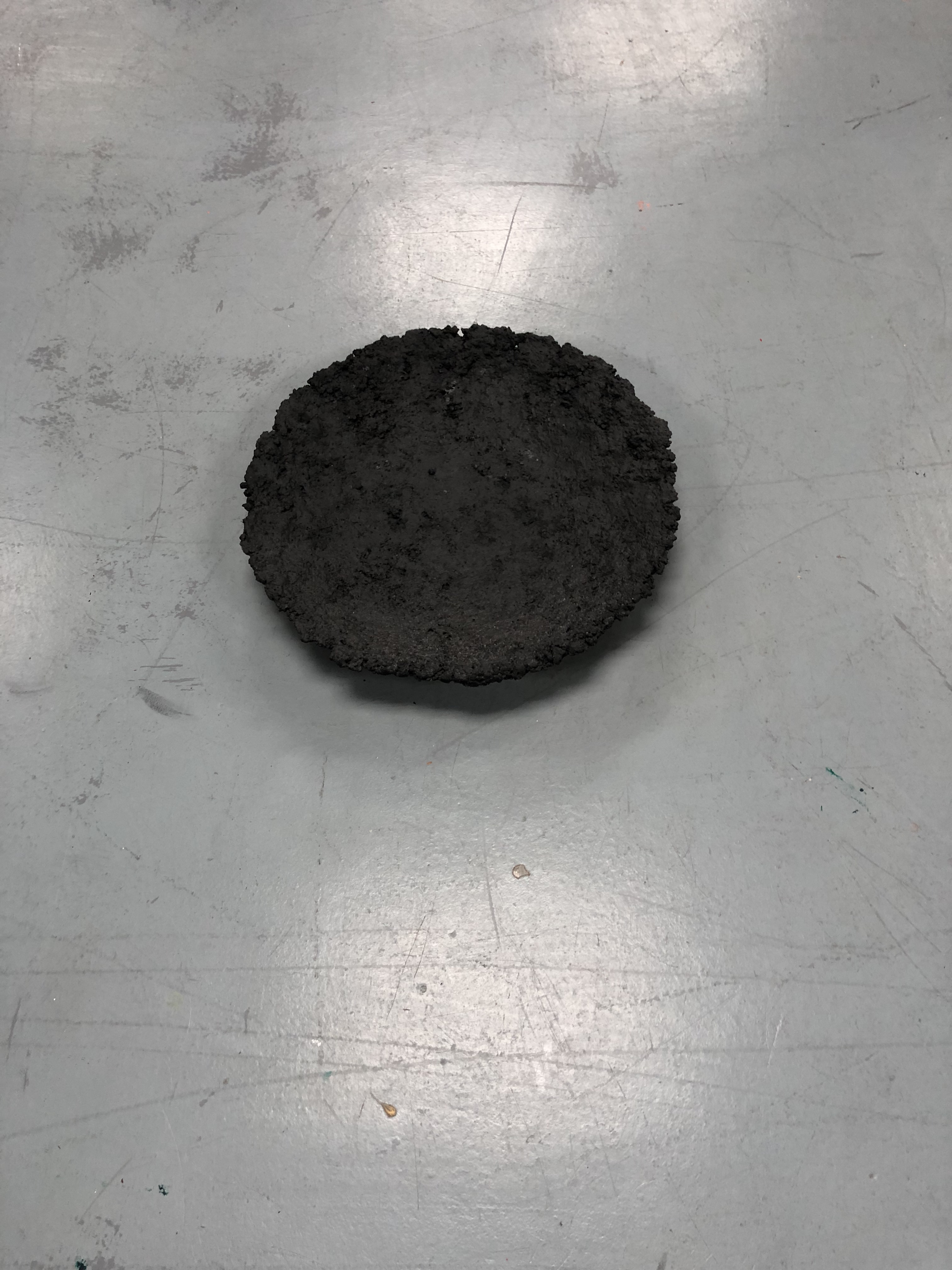

Bill: As a young man, I wanted to be a history teacher, but ended up in administrative museum and curatorial work. I didn’t really start making art until I was in my late 40’s as I felt I wasn’t emotionally or intellectually prepared to do so before that time. I received my M.A. in Museum Studies and Installation Design at Cal State Fullerton. I lived in Atlanta where I was the Visual Arts Program Director for the Southern Arts Federation and the Curator of the Atlanta International Museum of Design. Later I was the Executive Director of , context Visual Arts Center in Charlotte, North Carolina.
In 2003 I moved from Charlotte to the desert with Pat, my husband of 44 years. I became the Executive Director of the Coachella Valley Arts Alliance and then established this place and changed the name to Coachella Valley Arts Center which is a regional cultural center offering artist’s workspace, exhibition programs and workshop/classroom space. I negotiated a lease for this building with the city of Indio for $1.00 a year but I pay for all the expenses without support from the City (almost all CVAC expenses relate to utilities). There are currently ten resident artists here including glass artists, a metal sculptor and an expanding glass program with a stained-glass project in the works. All the space is in use and I believe there is great energy in the building. I don’t believe it will ever be finished as I have no assistants, (other than the cats) and there are always things to do. There is nothing else like CVAC in the desert and it is the only place offering glass workers and kilns.
Bill: Well I get tired sometimes but generally it’s not physical…it’s mostly mental. I’m 72, I’m in great shape but I do get frustrated because no one takes things as a seriously as I do.
Bill: I’m up very early. I first check my emails, let the dogs out and then go to the gym. I do an hour of weights and 30 minutes of Thai-Chi and then its home again to take the dogs for a walk. I’m usually here at CVAC by 7:30-8:30 and work until 12 or later depending on the work I have or the classes and/or artists here. Later in the day I take a run and hopefully Pat and I have time in the evening for a little British TV.
Bill: I have a few heroes. Sol LeWitt, the fiber artist Lenore Tawney and others. I met Sol Lewitt in New York many years ago when I was there on business. Through a friend, I was able to stay in LeWitt’s loft in Chinatown when LeWitt was out of town. Just being in his loft…was the best! One morning I woke, and, in my boxers made coffee. When I turned around, there he was, LeWitt, in his briefs (laughed). I jumped and apologized. He had gotten home from Europe early and since he knew I was there, he had slept on the sofa and woke up to my coffee. We sat together, we talked and I just listened to him. He was so sweet and human and so consistent with his advice…I will remember his words until I die. He said, “Don’t worry about what people think, just do what you need to do, and you will be happy”. Today I take that advice without regrets.
Schinsky is natural born teacher. He has presented art related lectures and programs at local, state and national gatherings, he has participated as a member of the Grants Review Panel for the National Endowment for the Arts and was an adjunct instructor at the College of the Desert, teaching Introduction to Art, while admitting he resists a traditional approach to teaching. He sees his job at CVAC as not only administrative and curatorial but also as someone who can push people to grow.
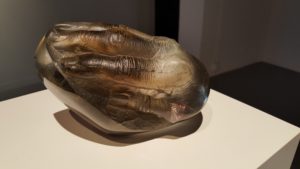 Bill: I like to let things unfold. I do have a future project that will take some time to complete. I sit on a Veterans Advisory group headed by Congressman Raul Ruiz. Ruiz mentioned that he wanted to put together a Vietnam veteran’s event for the community, but I wanted something bigger than an event. I proposed the “Welcome Home Once Withheld: Vietnam Veterans Project”. It would allow for one veteran from each of Riverside County’s 30 cities to relate their own unique coming home experience. Using the concept of the handshake as a “welcome home”, each veteran would have their hand cast in glass and while the mold dries, each veteran will be video-taped recounting their coming home memories. It is an intense project, but I believe that veterans verbalizing their memories will improve not only the lives of the participating individuals but in turn, the public will gain great insight from their stories. This is not an inexpensive project and it will require funding, but It is an important project, a bridge between the humanities and art… about life changing experiences told without censorship.
Bill: I like to let things unfold. I do have a future project that will take some time to complete. I sit on a Veterans Advisory group headed by Congressman Raul Ruiz. Ruiz mentioned that he wanted to put together a Vietnam veteran’s event for the community, but I wanted something bigger than an event. I proposed the “Welcome Home Once Withheld: Vietnam Veterans Project”. It would allow for one veteran from each of Riverside County’s 30 cities to relate their own unique coming home experience. Using the concept of the handshake as a “welcome home”, each veteran would have their hand cast in glass and while the mold dries, each veteran will be video-taped recounting their coming home memories. It is an intense project, but I believe that veterans verbalizing their memories will improve not only the lives of the participating individuals but in turn, the public will gain great insight from their stories. This is not an inexpensive project and it will require funding, but It is an important project, a bridge between the humanities and art… about life changing experiences told without censorship.
Bill: Yes, exciting and emotionally intense.
Bill: I would say that I have had the most remarkable career and have met some of the most famous artists in the world. I met Louise Nevelson once and she told me something that many artists have also said to me…”be true to yourself”. I agree, I believe it’s about being truthful and it’s about one’s uniqueness. I don’t do religion, but I do my work and that is rejuvenation for me.
Bill: I would say, don’t worry about what you can’t control. Do what you love. Pay attention to what’s going on in the world. What I do, is all about the world. It is the job of the artist to make people think, to think about the world.
Bill is an historian, a teacher, an artist, a community leader and force to be reckoned with. I hope you take the time to visit Coachella Valley Art Center in Indio California. It truly is a gem and should be visited. I know You will be surprised and inspired.
